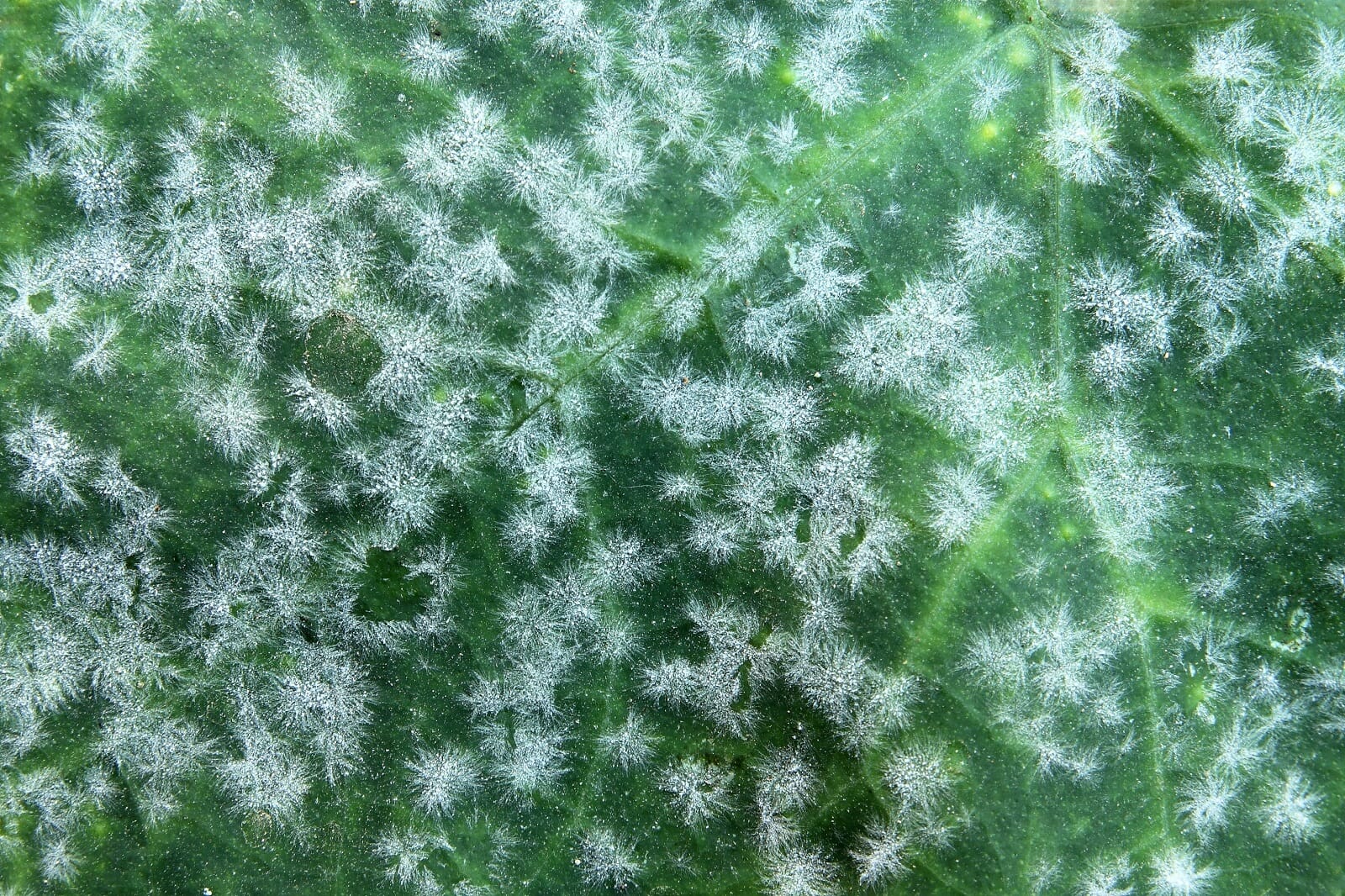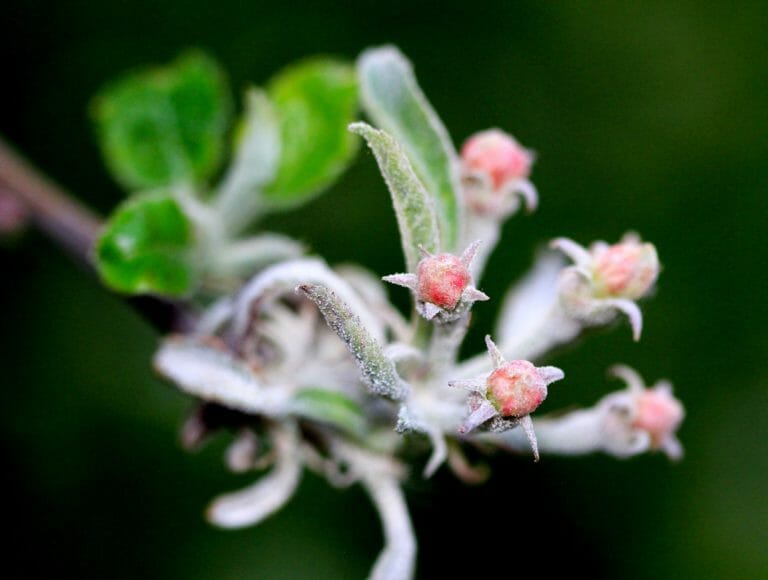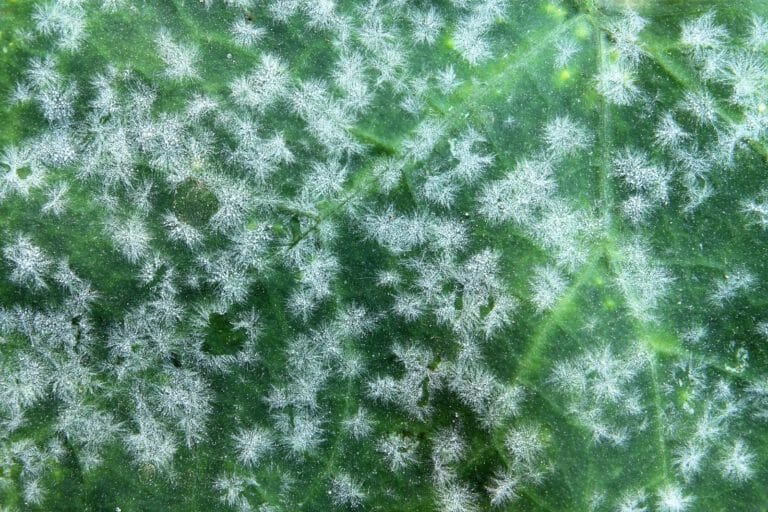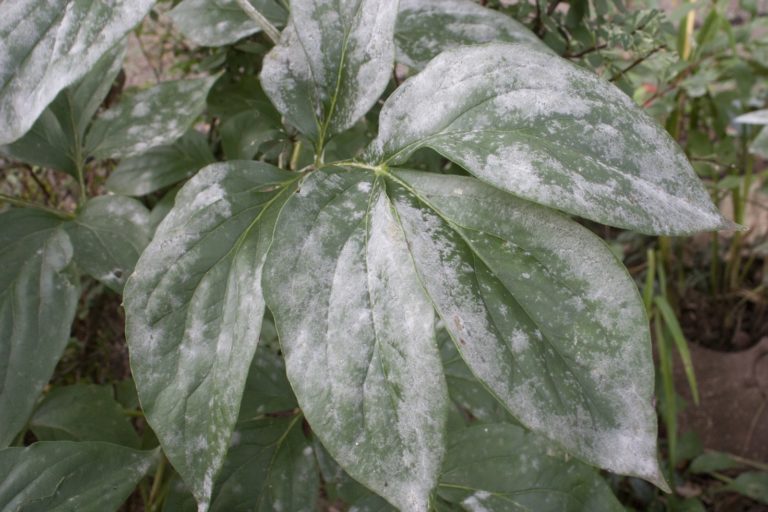Powdery Mildew and Fungicides
Part 2: Treatment Options

Treatment Options
Inorganic: Simple chemicals are often an effective and efficient method to prevent and manage fungal infections. Some chemical treatments are safe to use on edible plants. Rinsing with dilute hydrogen peroxide or applying potassium salts can protect against initial fungal infections and slow the spread of existing infection. Though hydrogen peroxide generally has a very short residual time.
OxiDate contains 27% hydrogen peroxide and 2%PAA (peracetic acid)
Potassium bicarbonate works to draw moisture out of the mildew hyphae. It can be a very effective contact fungicide. Mildew cannot easily develop resistance to desiccation. In addition, some of the potassium is absorbed by the plant. This makes it a better product than sodium bicarbonate (baking soda) as too much sodium is very bad for plants.
Kaligreen (82% micro-encapsulated potassium bicarbonate) is one representative brand. GreenCure is another potassium bicarbonate (85%potassium bicarbonate) based fungicide.
Vital, by Phoenix Environmental Care is a Potassium Phosphate fungicide some have had success with. MOA Group 33.
Syngenta’s Appear® fungicide contains phosphorous acid salt (potassium phosphite) 53.3%.
JMS Stylet-oil is made-up out of “severely” hydro-treated paraffinic oil (a petroleum based oil). Many growers report this is an effective protectant.
SM-90 is coriander oil, modified canola oil, and an emulsifier (solubilizes the oils).
Some growers claim success using alkaline water. Many mildews cannot grow in highly basic pH. Simply spray foliage frequently with water at 8.0+ pH. Wetting buds isn’t recommended. Note that some foliage washes (Mega Wash, Ultimate Wash) were recently found to contain unlisted (non-labeled) pyrethrins.
Pro-TeKt 0-0-3, according to the manufacturer, “supplies higher levels of potassium and silicon to help plants build stronger cell walls. The stronger cell walls provide a […] barrier against […] invading fungi.” Its analysis gives potassium (K2O): 3.7% and silicon (SiO2): 7.8%. The company doesn’t claim root-feed or foliar spray to be better, but there’s evidence that continuous root uptake helps systemically while foliar provides some protectant action.
Copper compounds show variable performance, and phytotoxicity is likely if foliar feeds or washes tend toward acidic. Copper compounds can have a role as protectants in your product rotation.
Phyton-35 is copper (II) sulfate pentahydrate
Organic: Sprays of Neem oil (pressed from the fruits and seeds of the Neem tree), garlic extracts, insecticidal soaps such as M-Pede (based on potassium fatty acids), and dilute (2 to 5%) citric acid (which may reinforce the plant’s carbohydrate metabolism against infection).
Probably the oddest organic treatment is a 1:9 dilution of skim milk (use non-fat because fats can go rancid and smell bad). No one knows the exact mechanism of prevention, but one candidate is ferroglobulin, a protein in whey, which produces oxygen radicals when exposed to UV light. Contact with oxygen radicals is especially damaging to rapidly growing tissue such as a fungal infection.
Sulfur: Sulfur vaporization is an economically attractive method for larger grow rooms. Sulfur vaporizes well at around 300°F. Sulfur can also be suspended in water and sprayed which may be more applicable to smaller setups. Sulfur dusting produces a slightly acidic environment and helps prevent spores from germinating on leaf surfaces. Sulfur can irritate eyes and lungs; goggles and respirator should be worn when sulfur is in the air. The spray form of sulfur is probably most easily used for plant protection purposes. Sprays usually incorporate surfactants, which improves mixing with water.
Sulfur vaporization is always done during lights-off time and with exhaust fans shut down. Recommendations are usually to run for 12 hours initially (always keep circulation fans running), then 1 to 4 hours per night. For preventative use, run the vaporizer 2 times a week. For active infections, usually vaporize 4 times a week.
Don’t apply sulfur to plants on which you’ve used oil-based products within the last 30 days; the combination causes leaf burn on most plants. Also, because of corrosion concerns, sulfur burners may invalidate warranties on electronic equipment such as digital ballasts.
Fungal and bacterial preparations: There are several preparations of mycoparasitic fungi. These are fungi that parasitize other fungi (sometimes called hyperfungi). There are also a few brands using a strain of specially-cultured bacteria to control powdery mildew infections.
Bayer Serenade Garden product employs a patented strain (QST 713) of Bacillus subtilis.
Ready-To-Use Active: 0.074% Bacillus subtilis
Ready-To-Spray and Concentrate Active: 1.34% Bacillus subtilis
Cease is 1.3% Bacillus subtillis
Actinovate contains- Streptomyces lydicus WYEC 108* 0.037%
Sonata contains- Bacillus pumilusstrain QST2808 1.38%
Lactobacillus acidophilus is another antagonistic bacterium.
AQ 10® is based on the hyperfungus Ampelomyces quisqualis. This fungus parasitizes hyphae, conidiophores and cleistothecia of powdery mildew. For AQ-10 to germinate, there must be powdery mildew present for it to feed on. So, application must begin at the first sign of infestation.
Specialized fungicides: When applying complex chemicals such as most of these engineered fungicides, use a Tyvek suit, chemical resistant gloves, shoe covers or dedicated boots, and some sort of head covering. Most manufacturers recommend wearing a respirator while applying their products—read and follow the instructions. Beyond just extending your life at the very end, shielding yourself from the raw forms of these chemicals can help maintain your health all through the middle part.
Eagle20 [DMI]: myclobutanil 19.7%
Spectracide Immunox: “Spray Concentrate for Gardens”, myclobutanil 1.55%.
Syngenta produces a wide array of fungicides:
Heritage Action™: crystalline silica, quartz and cristobalite, kaolin clay, azoxystrobin, acibenzolar-S-methyl
Daconil Action™: propylene glycol, chlorothalonil, acibenzolar-S-methyl
Banner Maxx [DMI]: tetrahydrofurfuryl alcohol, propiconazole
Banner Maxx® II fungicide: propiconazole
Secure®: fluazinam
Velista®: kaolin clay, penthiopyrad
Sovran: kresoxim-methyl (by Cheminova Inc. -FMC Agricultural Solutions-)
Bayleton FLO [DMI]: triadimefon, glycerine, polyethylene-polypropylene copolymer, naphthalene and alkyl naphthalene sulphonic acids, formaldehyde condensate, sodium salt
Spectro-90: chlorothalonil, thiophanate-methyl (by Nufarm)
Approved Chemicals
A list of Colorado-approved chemicals: https://www.colorado.gov/pacific/sites/default/files/atoms/files/Pesticides%20allowed%20for%20use%20in%20cannabis%20production%2001-26-17.pdf
Colorado Government Site with good information:
https://www.colorado.gov/pacific/agplants/pesticide-use-cannabis-production-information
Note: All pictures and diagrams here were originally produced by others. They are the clearest and best examples available with which to educate and inform. Some were slightly adapted for this use.
This educational document was written, compiled, and adapted by Mike Steffes of Quest Dehumidifiers.
Powdery Mildew and Fungicides Parts 1–3
Published on Jun 19 2017
Last Updated on Feb 20 2024
Categories: Agriculture, Bud Rot, Cannabis Mold, Mildew, Mold, Powdery Mildew



